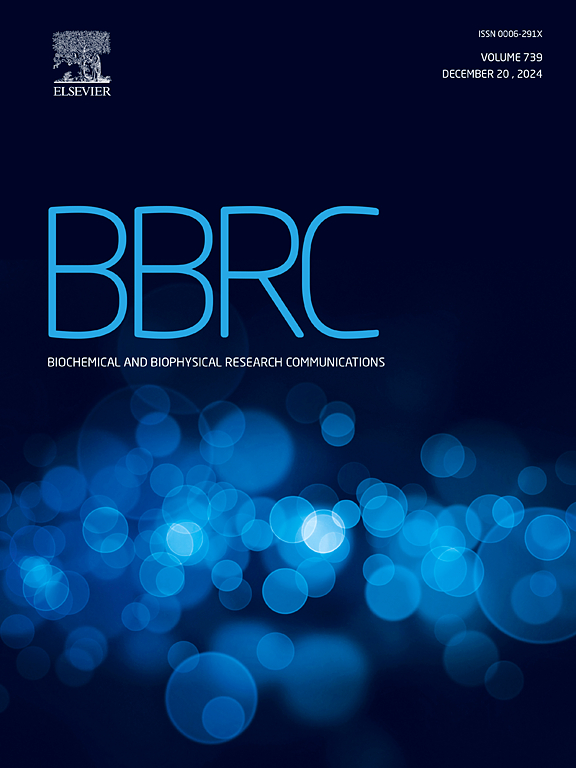IF 2.5
3区 生物学
Q3 BIOCHEMISTRY & MOLECULAR BIOLOGY
Biochemical and biophysical research communications
Pub Date : 2025-01-20
DOI:10.1016/j.bbrc.2025.151365
引用次数: 0
摘要
对乙酰氨基酚(APAP)是一种常用的解热镇痛药。过量服用 APAP 是导致药物性肝损伤和急性肝衰竭(ALF)的主要原因。SW033291 已被证明在多种疾病的组织再生中发挥作用;然而,它在 APAP 引起的肝损伤后促进肝再生的潜力仍未得到研究。因此,本研究通过建立 APAP 诱导的小鼠急性肝损伤模型,重点探索 SW033291 对肝损伤的治疗作用和机制。结果显示,用 SW033291 治疗可降低血清丙氨酸氨基转移酶(ALT)和天门冬氨酸氨基转移酶(AST)活性,减少肝坏死面积,增加谷胱甘肽(GSH)水平,降低组织丙二醛含量、还能降低肝损伤小鼠组织中丙二醛(MDA)的含量以及肿瘤坏死因子-α(TNF-α)、白细胞介素-1β(IL-1β)和白细胞介素-6(IL-6)的表达水平。它还能通过增加组织中前列腺素 E2(PGE2)的水平来促进肝细胞增殖和抑制肝细胞凋亡。总之,SW033291 能够通过促进肝脏再生、减轻氧化应激和调节炎症反应来改善 APAP 引起的小鼠肝损伤,因此有望成为开发针对急性肝衰竭的治疗干预措施的候选药物。本文章由计算机程序翻译,如有差异,请以英文原文为准。
SW033291 promotes liver regeneration after acetaminophen-induced liver injury in mice
Acetaminophen (APAP) is a commonly utilized antipyretic and analgesic drug. Overdose of APAP is a primary contributor to drug-induced liver injury and acute liver failure (ALF). SW033291 has been shown to play a role in tissue regeneration in various diseases; however, its potential to facilitate liver regeneration following APAP-induced hepatic injury remains unexamined. Thus, this study focused on exploring the therapeutic impacts and mechanisms of SW033291 on liver damage by establishing models of APAP-induced acute liver injury in mice. The results showed that treatment with SW033291 reduces serum alanine aminotransferase (ALT) and aspartate aminotransferase (AST) activities, decreases the area of hepatic necrosis, increases glutathione (GSH) levels, and decreases tissue malondialdehyde (MDA) content, as well as the expression levels of tumor necrosis factor-alpha (TNF-α), interleukin-1β (IL-1β), and interleukin-6 (IL-6) in mice with liver injury. It could also promote hepatocyte proliferation and inhibit apoptosis by increasing tissue prostaglandin E2 (PGE2) levels. In conclusion, SW033291 demonstrates the capacity to ameliorate APAP-induced hepatic injury in mice by fostering liver regeneration, attenuating oxidative stress, and modulating inflammatory responses, thereby presenting itself as a promising candidate for the development of therapeutic interventions targeting acute liver failure.
求助全文
通过发布文献求助,成功后即可免费获取论文全文。
去求助
来源期刊
CiteScore
6.10
自引率
0.00%
发文量
1400
审稿时长
14 days
期刊介绍:
Biochemical and Biophysical Research Communications is the premier international journal devoted to the very rapid dissemination of timely and significant experimental results in diverse fields of biological research. The development of the "Breakthroughs and Views" section brings the minireview format to the journal, and issues often contain collections of special interest manuscripts. BBRC is published weekly (52 issues/year).Research Areas now include: Biochemistry; biophysics; cell biology; developmental biology; immunology
; molecular biology; neurobiology; plant biology and proteomics

 求助内容:
求助内容: 应助结果提醒方式:
应助结果提醒方式:


